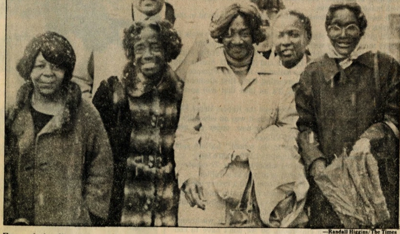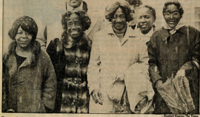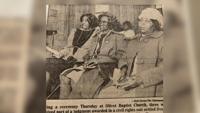More than 40 years ago, five black Chattanooga women set out on a mission to get justice and end Ku Klux Klan violence in the Scenic City.
The women were attacked in April of 1980 and the violence sparked protests, litigation, and ultimately brought justice to those who faced centuries of harm.
READ MORE | PART 2: How the Chattanooga Five shaped today's civil litigation
"Dusk to dawn. When it got ready to get dark, we had to be home and sitting on that front step. Not making it on that front step, but sitting on that front step," said Nathaniel Metcalf, the grandson of Fannie Mae Crumsey.
The Crumsey family says they will never forget April 19, 1980, in Chattanooga, TN.
"We was at the basketball court on Park Avenue, playing basketball, what we did every day when we got out of school. One of our little siblings came up there and said, 'Grandmama said get home' and we said, 'why man, we in the middle of the game' and she said, 'the Klan was supposed to be coming through shooting,'" said Metcalf.
Three men, all members of the Justice Knights of the KKK, drove down 9th Street (now known as MLK Boulevard) armed with two shotguns that were loaded with birdshot.

The Chattanooga Five | (Left to Right) Opal Jackson, Katherine Johnson, Viola Ellison, Betty Lawrence Lewis (Attorney), Lela Mae Evans. Photo courtesy of Randall Higgins
After burning a cross near the railroad tracks, Bill Church, Larry Payne and Marshall Thrash drove back down 9th Street, just as four black women Viola Ellison, Lela Mae Evans, Katherine Johnson and Opal Lee Jackson were walking out of a nightclub.
"We weren't bothering nobody, just standing on the corner waiting on our taxi to come by. We looked up and seen a ball of fire. Just like a broad daylight and before you know it we just got shot and went on down," said Jackson in a 2020 interview.
Only moments later, the men continued four blocks down to where a woman named Fannie Mae Crumsey was gardening in her yard.
"We got home, grandmama told us said, 'Hey I need some more water for my flowers y'all go get it.' So we got the buckets, we stepped in side. By the time we stepped inside, we weren't inside probably 30 to 45 seconds. All we heard was boom boom and we ran back outside and that's when we seen my grandmama over like this and when she came up she was bleeding like this," recalled Metcalf.
Crumsey was struck by flying glass. More than 40 years later, the impact of the pellets still leaves a dark reminder on the wall of the home.
The klansmen were arrested and charged with attempted murder, but acquitted that summer by an all-white jury.
Thrash was the only klansmen sentenced to lesser charges, receiving nine months in jail. He was released after just three and a half months.
When the public felt like justice wasn't served, Chattanooga erupted in four nights of protest. People marched in the streets, downtown businesses were firebombed, and Crumsey's grandchildren say she shielded them from all of it.
"It really didn't change because the doors weren't locked before it happened and the doors weren't locked after it happened. She didn't turn people away no matter what the nationality or race, creed or color, and she didn't do it after it happened," said Juanita Toney, Crumsey's granddaughter.
"We actually didn't know it was the Klan. She said that it was all just some crazy drunk people. We didn't know it was the Klan until the community started speaking on it. She didn't talk about racism, she didn't believe in racism," added Ronald Crumsey.
The grandchildren say their grandmother and the four other women just wanted justice.
"Two of them were really frail, I mean, when I met them that had over 100 shotgun pellets still in their legs. Ms. Crumsey wasn't physically injured, she had some glass splattered, but she certainly suffered severe post dramatic distress and emotional distress," explained Attorney Randolph McLaughlin.
McLaughlin was invited to Chattanooga by the head of the NAACP to help the women get justice.
"At CCR we had developed this theory that we could use this ancient, this 1871, statue in the year 1980 to sue the Ku Klux Klan. It had never been used in any civil litigants successfully, and we said this would be the perfect statue to use as a test case. Chattanooga was case," said McLaughlin.
With his help, the five women decided they were going to sue the Klan.
"So, we filed this case both on behalf of the women and on behalf of all black residents of Chattanooga to prevent Klan violence in the future," said McLaughlin.
The five women sued the Klan in February of 1982.
In 2020, the process sparked interest from Civil Rights Attorney Ben Crump to be part of a documentary called "How to Sue the Klan."
Part 2: How the Chattanooga Five shaped today's civil litigation















